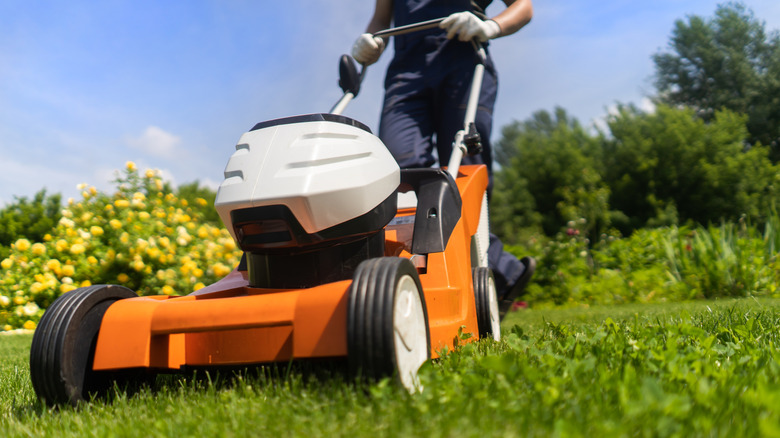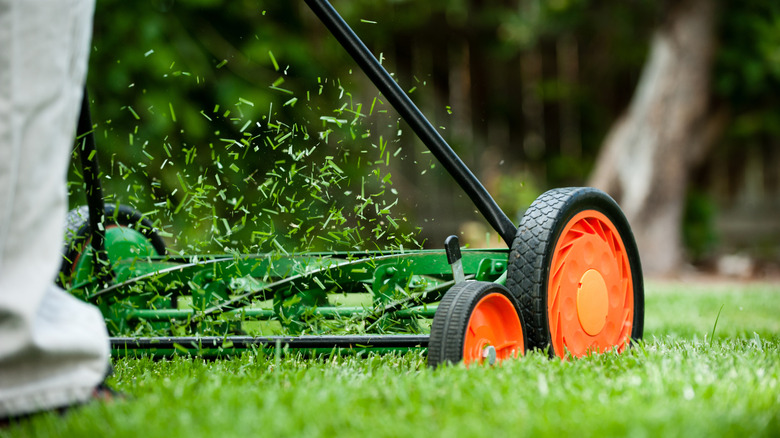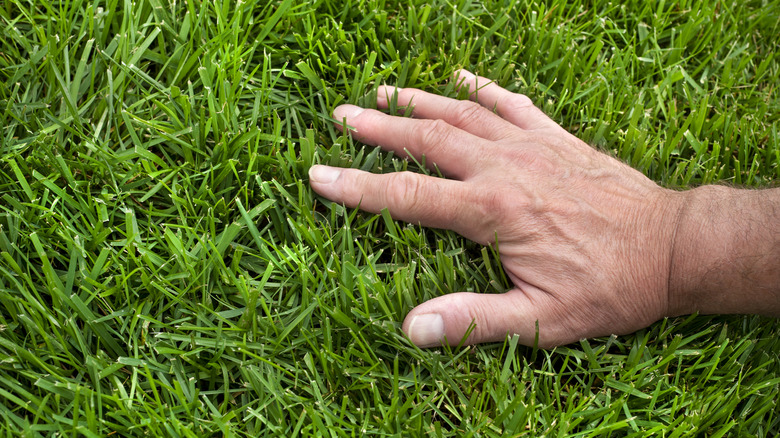Why You Should Start Leaving Grass Clippings On Your Lawn After Mowing
Whether you love it or hate it, mowing the lawn is one of those jobs you can't ignore. Your un-mowed lawn may draw the ire of neighbors, after all. If you want to spend less time on this task, you may have interest in finding methods to mow your lawn more efficiently. One of the best ways to save time in lawn care is by leaving the grass clippings on the lawn. Beyond saving time, you receive several other benefits by leaving the cut grass on the yard instead of bagging it, including creating a natural mulch layer, saving water, adding fertilizer, and suppressing weed growth.
However, time saving is an especially appealing advantage of following this method of yard care. Repeatedly stopping and emptying a collection bag slows down the time needed to mow, especially if you have a large lawn and have to stop a dozen times or more. You might have to walk a long way with the bag to your pile of yard waste compost or to the yard waste recycling bin or paper recycling bags, which further increases the amount of time required to bag the lawn clippings. Additionally, leaving the mowed grass on the yard to decompose saves you time by reducing the amount of watering required. Grass clippings are made up of about 85% water, and the decomposing clippings return that moisture to the soil. If you're struggling to water the lawn regularly because hauling hoses and sprinklers across the yard is too labor intensive, allowing the grass clippings to provide some moisture saves you time and labor.
Nutritional benefits that the grass clippings provide to the yard as they decompose
Lawn clippings give the grass plants in the yard valuable nutrients they need to grow stronger. They contain key nutrients like nitrogen, phosphorus, and potassium. These nutrients give your lawn strength to stand up to stressful environmental conditions like poor weather or pests. When you leave the grass clippings on the yard, you provide up to 50% of the fertilizer needed to maintain a healthy lawn. This means you won't have to apply as much man-made fertilizer separately, saving you time and money. By reducing the number of fertilizer applications you need to do, you'll reduce the risks associated with using too much man-made fertilizer, such as root burn or negatively affecting the pH soil balance.
When you choose to mulch your grass, it means that you're using the lawn mower blades to chop the grass into smaller pieces before they fall to the ground. The shape of the deck of the lawn mower encourages mulching by keeping the cut pieces circulating until the blades can make them small enough to fall downward. Grass clippings of 1 inch or shorter will easily reach the soil surface of the lawn and can decompose faster, which is why you should make sure you have a lawn mower capable of mulching when you decide to leave the mowed blades on the lawn. If you have a walk-behind mower, it almost certainly has mulching capabilities built into it. If you have a riding mower, you might have to contact the manufacturer to purchase a mulching kit separately.
How leaving the grass clippings on your lawn strengthens the grass and soil
As another benefit of leaving the grass clippings on the lawn is developing stronger growth. The decomposing mulched grass will create a layer over the soil under the healthy grass blades, which helps prevent weeds from growing. Suppressing weeds organically using this method means you don't have to use as many weed-killing chemicals, which can be harmful for the environment and for human health.
By leaving decomposing grass clippings on the lawn, you increase the amount of organic matter in the soil. This gives the soil the ability to maintain cooler temperatures during hot summer days. Cooler soil encourages root growth, improving the overall health of the grass as it grows. When soil temperatures surpass 85 degrees Fahrenheit, the roots may struggle to absorb water. When this kind of heat stress is occurring, root growth may stop, causing the roots to go dormant and leading to discoloration on the grass. Leave the cut grass on the lawn as mulch keeps the soil temperature cooler because the mulched grass encourages water retention in the soil. Additionally, soil with higher levels of organic matter are better able to resist erosion during times of heavy rain. It is able to support many types of beneficial soil organisms, like earthworms, which further improve the nutrients in the soil.


